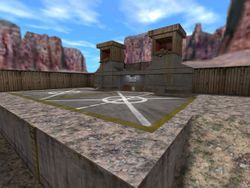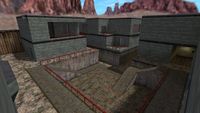Crossfire (multiplayer map)
For other uses, see Crossfire (disambiguation). |
| This article is non-canon. | ||
|---|---|---|
The subject matter of this article does not take place in the "real" Half-Life and Portal universe and is considered non-canon. |
- "Crossfire is a total blast. When the sirens go off warning people that the air strike is coming in, everybody scrambles for the bunker, and, well, it's a lot of fun sitting in the tower with the emplacement cannon."
- —Robin Walker[src]
Crossfire is a map in the multiplayer mode of Half-Life. It was added to the game in patch version 1.0.0.8[2] which was released on January 13, 1999.[3] The official Opposing Force version of the map was released on December 6, 1999.[4]
Contents
Overview[edit]
Crossfire is meant for large groups of players.[2] The map is composed of two main areas: the building compound with a courtyard and the "Satellite Operations" bunker near a double helipad. They are connected by several passageways including a long underground tunnel the middle of the map. The former area puts emphasis on vertical play featuring three distinct planes, while combat in the latter location is more heavily focused on a level playing field. The map's hallmark is a button inside the bunker that launches an airstrike killing everyone caught outside it. With spawn points located entirely within the building complex, Crossfire incentivizes venturing out of the initial area.
Comprising numerous rooms and hallways, the building compound revolves around close quarters combat with the only open area being the courtyard from which most of the passageways to the bunker can be accessed. This location offers a very large assortment of weapons as well as health and Suit Chargers, Medkits, Batteries, and Long Jump Modules, but the ammunition for them is somewhat limited. Button-controlled lifts are the primary mean of ascending in the buildings, while balconies and large windows allow for a quick getaway from the higher floors. The side of the complex facing the bunker features numerous exits from the area and provides plenty of cover against the bunker's defenses.
The largest open area in the map, the raised double helipad, is accessible by two ladders and two ramps on the low ground and by jumping from the upper level of the complex on the high ground. The helipad connects to the entrance of the bunker and its two cannon towers that can be climbed up into. The cannons can be manned by players, firing large explosive rounds at a slow rate. The lights in these towers indicate if the airstrike button inside the bunker is open. Red lights mean it's still locked, while green lights mean it's available. At the base of each tower is a pillbox that houses a supply of Crossbow belts. These enclosures are directly connected to to the cannon emplacements above by a vertical shaft. The bunker's entrance lobby is equipped with four health Chargers, the use of which requires turning one's back to the helipad area. Hallways leading from the lobby provide access to the guard posts as well as two supply rooms with large quantities of ammunition for various weaponry. The computer console with the airstrike button is situated at the back of the bunker.
When the airstrike button is pressed, it retracts into the console as sirens located throughout the map start sounding. Soon, the windows of the pillbox enclosures slam shut, and the bunker's main entrance door slowly begins to close. Once it is sealed, the shafts in the towers also close, blocking off the last avenues of entry. After a few seconds, the airstrike commences, and anyone caught outside the bunker is instantly killed as every player's screen flashes white. There is then a three minute waiting period until the next airstrike can be called, at which point the button will reveal itself again from the console.
Half-Life Deathmatch: Source[edit]
Crossfire was updated for Half-Life Deathmatch: Source and had number of visual changes implemented. Among the features brought with the Source engine upgrade were modified lighting, a 3D skybox, lens flares on light sources, breakable glass windows, and reflective and displacement surfaces. This version of the map also contains more cosmetic details, incorporating more brush elements, such as extruded trim details added to the walls and ceilings inside rooms, and additional texture variety, such as the three main buildings in the courtyard being given color-coded stripes in their interiors and hazard strips added around the lift openings. An inaccessible new top floor was added to the middle building, an antenna and what appears to be an air conditioning unit were placed on a courtyard rooftop, two sirens were connected by a wire, and the appearance of the tower cannons was completely overhauled, now using a model rather than being built out of brushes.
Several gameplay aspects and functionalities have been altered. The cannons can no longer be used, and the color of the tower lights no longer change to reflect the status of the airstrike button. The state of the hatches for the vertical tower shafts is inverted, remaining closed for the majority of the time and only briefly opening for a few seconds before the airstrike commences. The secret room is now readily accessible simply by walking up to the hidden sliding panel. However, the room's characteristic blue lighting has been removed.
Behind the scenes[edit]
Dario Casali, the creator of Crossfire, based the map on a concept of having a location with defense capabilities that players would fight over, with the airstrike being a deterrent to not be caught outside of it. Starting its life as a modification of an area featured in the Surface Tension map c2a5e, Crossfire initially didn't include the cannons in the guard towers. They were added following a suggestion from Brett Johnson. The building compound was intended to be a place where players could stock up on weapons and then rush towards the bunker. In Casali's opinion, "the best way to successfully hold the bunker is by co-ordinating a team of people, some operating the big guns, some picking off enemy snipers." This kind of teamplay is what he aimed to encourage in the map.[5] Casali considers Crossfire to be his proudest gameplay accomplishment in Half-Life's multiplayer,[1] while Valve has regarded the level as their favorite teamplay map.[6]
An inaccessible room illuminated by blue lights with a Crossbow, Medkits, and Batteries can be found in the northwestern-most building. A portion of the wall in the room on the ground floor was meant to slide open and allow entrance. This secret room could be entered up until the last minute before Crossfire's public release. By the time the decision to remove it was made, only a very minor change to the level was permitted. The solution was to disable access to the room rather than completely deleting it.[1] Dario Casali's signature written in brushes can also be found hidden outside of the map under the double helipad.
Three security guards are placed around the map, possibly for the purposes of testing the airstrike's damage zones. They are normally not visible unless the level is run in singleplayer mode or monsters are enabled in multiplayer. As the sky texture is improperly defined in the map settings, Crossfire uses either the one from the last loaded map or the default desert texture.[7]
Crossfire spawned a sequel map in Half-Life called DoubleCross,[8] also created by Casali, and inspired the Half-Life 2: Deathmatch map Run Off.[9]
Gallery[edit]
Half-Life[edit]
The double helipad area of the Topside Motorpool in Surface Tension.
Half-Life Deathmatch: Source[edit]
References[edit]
- ↑ 1.0 1.1 1.2 Interview with Dario Casali on Planet Half-Life (July 15, 2004) (archived)
- ↑ 2.0 2.1 Half-Life News on Sierra Studios' official website (January 15, 1999) (archived)
- ↑ Half-Life Version 1.0.0.8 on Blue's News (January 13, 1999)
- ↑ 'Tis the Season: New Op For Maps on Official Half-Life: Opposing Force website (December 6, 1999) (archived)
- ↑ An Interview with Dario Casali on Voltron's Map Workshop (May 1, 2000) (archived)
- ↑ Exclusive New Half-Life Level on IGN (January 13, 1999)
- ↑ Crossfire map file
- ↑ DoubleCross map file
- ↑ News entry on Steam (April 22, 2004) (archived)























